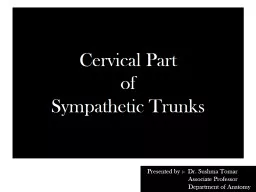

Presented by Dr Sushma Tomar Associate Professor Department of Anatomy Introduction There are two sympathetic trunks right amp left in human body Location ID: 910433
Download Presentation The PPT/PDF document "Cervical Part of Sympathetic Trunks" is the property of its rightful owner. Permission is granted to download and print the materials on this web site for personal, non-commercial use only, and to display it on your personal computer provided you do not modify the materials and that you retain all copyright notices contained in the materials. By downloading content from our website, you accept the terms of this agreement.
Slide1
Cervical Part of Sympathetic Trunks
Presented by :- Dr.
Sushma
Tomar
Associate Professor
Department of Anatomy
Slide2Introduction
There are two sympathetic trunks (right & left) in human body.
Location-
Each sympathetic trunk is paravertebral in position.Each sympathetic trunk extends from the base of skull to the first coccygeal vertebra (base of coccyx).
Slide3Introduction contd…At the base of coccyx, both sympathetic trunks join to form
Ganglion Impar.
Slide4Sympathetic Trunks In The NeckLocation-Cervical part of sympathetic trunk lies in front of transverse processes of cervical vertebrae and neck of 1
st
rib.
Each sympathetic trunk presents 3 ganglia in the cervical part:-Superior.Middle.Inferior.
Slide5Sympathetic Trunks In The Neck contd…
Sometimes, inferior cervical and first thoracic sympathetic ganglion are fused to form a
cervico
-thoracic or stellate ganglion.
Slide6Sympathetic Trunks In The Neck contd…
Initially the number of cervical sympathetic ganglia corresponds with the number of spinal nerves.
Later, upper 4 cervical ganglia fuse to form
superior cervical ganglion.5
th
& 6
th
cervical ganglia fuse to form
middle cervical ganglion.
7
th
& 8
th
cervical ganglia fuse to form
inferior cervical ganglion.
Slide7Cervical Part Of Sympathetic Trunk Contd…
Cervical part of the trunk does not receive pre-
ganglionic
fibres through white rami communicantes from the cervical segments of the spinal cord.
Each cervical sympathetic trunk gives post-
ganglionic
fibres
via grey
rami
communicantes
to each of the 8
th
cervical spinal nerves.
Slide8Slide9Cervical Part Of Sympathetic Trunk Contd…
All pre-
ganglionic
fibres for the cervical sympathetic trunk are derived from lateral horn cells of T1-T5 segments of spinal cord.
These preganglionic
fibres
ascend through the trunk and finally relayed in 3 cervical sympathetic ganglia.
Slide10Superior Cervical GanglionLargest of the cervical sympathetic ganglia.
Formed by the fusion of
upper
4 cervical sympathetic ganglia.SHAPE- Fusiform (spindle).
LENGTH-
~2.5 cm.
LOCATION-
In front of transverse processes of C2 & C3 vertebrae.
Slide11It receives pre-ganglionic
fibres
mostly from upper 3 thoracic segments of spinal cord.
Superior Cervical Ganglion
Slide12Branches Of Superior Cervical GanglionDivided into following groups:-
Lateral.
Medial.
Anterior.Ascending.All branches convey post-
ganglionic
fibres
and some sensory
fibres
from the target organs.
Slide13Lateral Branches Of Superior Cervical GanglionThese are grey
rami
communicans to upper 4 cervical nerves.
Slide14Medial Branches Of Superior Cervical GanglionLaryngo-pharyngeal branches.
Cardiac branch.
Laryngo-pharyngeal branches-
Supply Carotid body.Form pharyngeal plexus with 9th & 10
th
nerves.
Cardiac branch-
Right cardiac branch joins with the
deep
cardiac plexus.
Left cardiac branch joins with the
superficial
cardiac plexus.
Slide15Anterior Branches Of Superior Cervical GanglionThese ramify around common carotid
aretry
, external carotid artery
and its branches.Sympathetic plexus around facial artery gives a filament to the
submandibular ganglion.
Sympathetic plexus around
middle
meningeal
artery
gives a filament to the
otic
ganglion
and another filament to the
genicular
ganglion
of facial nerve as
external
petrosal
nerve.
Slide16Ascending Branches Of Superior Cervical GanglionInternal Carotid Nerve.
Branches of Sympathetic Plexus around Internal Carotid Artery-
Carotido
-tympanic nerves.Deep petrosal nerve.
Nervus
conarii
-
supply pineal gland.
Communicating branches-
to trigeminal ganglion, 3
rd
, 4
th
, 5
th
& 6
th
cranial nerves.
Terminal branches-
supply the
piamater
and tarsal muscles.
Slide17Middle Cervical GanglionFormed by the fusion of
5
th
& 6th cervical sympathetic ganglia.LOCATION-
In front of transverse process of 6
th
cervical vertebra.
Just above the loop of inferior thyroid artery .
Slide18Middle Cervical Ganglion Contd…
COMMUNICATIONS-
Connected with inferior cervical ganglion by
ansa subclavia.
Ansa
subclavia
loops in front and below the first part of
subclavian
artery.
Slide19Branches Of Middle Cervical GanglionLateral.Medial.
Lateral branches-
These are grey
rami comminicans to 5th
& 6
th
spinal nerves.
Medial branches-
Thyroid branches.
Cardiac branches.
Slide20Slide21Inferior Cervical GanglionFormed by the fusion of
7
th
& 8th cervical ganglia.
LOCATION-
Between transverse process of C7 vertebra and neck of 1
st
rib.
Slide22Inferior Cervical Ganglion Contd…
Sometimes this ganglion joins with the first thoracic sympathetic ganglion to form
cervico
-thoracic or stellate ganglion.
Slide23Branches Of Inferior Cervical GanglionGrey rami
communicans
.Cardiac branches.Vascular branches.
Grey Rami Communicans-
To C7 & C8 cervical spinal nerves.
Vascular Branches-
Form plexuses around subclavian artery, 1
st
part of axillary artery and vertebral artery.
Slide24Applied AnatomyHORNER’S SYNDROME-A lesion affecting the pre-
ganglionic
fibres from T1 & T2 segments of spinal cord.Clinical Features-
Constriction of pupil (
miosis
).
Drooping of upper eyelid (
ptosis
).
Enophthalmos
.
Absence of sweating on affected half of face and head (
anhydrosis
).
Loss of
ciliospinal
reflex.
Slide25